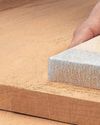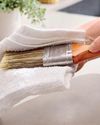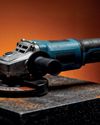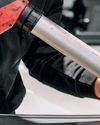UNDER PRESSURE
The Home Handyman
|May/June 2025
When it comes to outdoor cleaning, pressure washers stand out as a highly efficient solution.
-

They can remove layers of grime in a fraction of the time it would take with manual scrubbing and soapy water. Surfaces such as driveways, patios, cars, and even outdoor furniture can look almost new after a thorough wash. This impressive cleaning power comes from a focused jet of water that blasts away dirt. Instead of spending hours on your hands and knees, you can clean large areas swiftly and effectively.
However, the force that makes a pressure washer so valuable also requires careful handling. Without the right knowledge, you might damage surfaces, harm plants, or even injure yourself. Fortunately, learning how to choose the right machine and use it effectively isn't complicated. In this guide, we'll explore the essential features of pressure washers, the difference between various models, and techniques to help you get the best results. By the time you finish reading, you'll be ready to tackle everything from stained decking to muddy car wheels - safely, efficiently, and with confidence.
The basics: How pressure washers work
A pressure washer relies on a motor (electric or petrol) that powers a water pump. The pump takes in water from a hose or container and speeds it up, shooting it out through a nozzle at high velocity. The intensity of the spray is measured in pounds per square inch (PSI) or, sometimes, bars. You might also see a measure called "litres per minute" or "gallons per minute," which tells you the flow rate of the water. A balance of both pressure and flow rate determines how quickly and effectively the machine will clean.
Pressure (PSI or bar)
- Refers to how forceful the water jets out of the nozzle.
- Higher pressure helps blast off tough grime but can also damage delicate materials if not used carefully.
Flow rate (litres per minute or gallons per minute)
- Indicates the amount of water the machine can expel in a set period.
This story is from the May/June 2025 edition of The Home Handyman.
Subscribe to Magzter GOLD to access thousands of curated premium stories, and 10,000+ magazines and newspapers.
Already a subscriber? Sign In
MORE STORIES FROM The Home Handyman

The Home Handyman
KEEP YOUR HOUSE CRITTER FREE
With winter fast approaching, outdoor critters seeking to regulate their temperature are trying their best to get inside. Ants, spiders, moths, mosquitoes, fruit flies, stink bugs, termites, silverfish, and ladybugs, to name a few, can easily make their way into homes, and once they've settled in, it's often hard to get them out.
6 mins
Jul/Aug'25

The Home Handyman
SECRET HIDEOUTS
We all have things we would prefer to keep out of plain sight - family heirlooms, wedding rings, expensive jewellery, medicines or even weapons. Sometimes we just want to keep household items hidden in order to declutter a space. Whether you want to hide items for safety or financial reasons, or simply want to keep your bedroom tidy, there are a few clever storage ideas that could help you out.
2 mins
Jul/Aug'25

The Home Handyman
ABRASIVES DEMYSTIFIED
Abrasive materials are indispensable in countless industries, from woodworking and metal fabrication to automotive repair and electronics manufacturing.
3 mins
Jul/Aug'25

The Home Handyman
THINNERS VS. TURPENTINE
If you've ever finished a painting or staining job and been left wondering how best to clean your brushes, you're not alone. One of the most common DIY questions is: Should I use thinners or turpentine to clean my brushes? The answer depends on the type of paint or coating you've used. Using the wrong solvent can damage your brushes, or worse, make the cleaning job even harder.
2 mins
Jul/Aug'25

The Home Handyman
KEEP THE COLD OUT
Did you know that homes in South Africa are either insulated to a poor standard, compared to European nations, or have no form of insulation at all. In 2011 our National Building Regulations made it compulsory to fit thermal insulation in new buildings and additions to building structures.
5 mins
Jul/Aug'25

The Home Handyman
ANGLE GRINDERS — MASTERING THIS VERSATILE TOOL
When it comes to versatile tools in a DIYer's arsenal, few can match the power and practicality of the angle grinder.
2 mins
Jul/Aug'25

The Home Handyman
KITCHEN CARE – MAINTENANCE TIPS FOR KEY AREAS
The kitchen is the heart of the home where meals are made, memories are shared, and chaos sometimes reigns. But like any hardworking space, your kitchen needs regular maintenance to keep it functional, safe, and looking great.
2 mins
Jul/Aug'25

The Home Handyman
Separating Fact from Fiction
Maintaining your home can be a daunting task, especially with the plethora of DIY tips and tricks floating around the internet.
2 mins
Jul/Aug'25

The Home Handyman
SEALANTS SIMPLIFIED: WHAT TO USE AND WHERE
Whether you’re tackling a weekend DIY fix, remodelling your home, or involved in large-scale construction, sealants are a silent hero that play a vital role in creating watertight, airtight, and secure finishes.
3 mins
Jul/Aug'25

The Home Handyman
COMMON FRIDGE/FREEZER FAULTS
Your fridge freezer is one of the hardest-working appliances in your home, so when it stops performing as it should, it can cause major inconvenience. The good news? Not every fault means an expensive call-out or a trip to the shops for a new one. In many cases, you can fix the issue yourself with a little know-how and a few basic tools.
3 mins
Jul/Aug'25
Listen
Translate
Change font size

